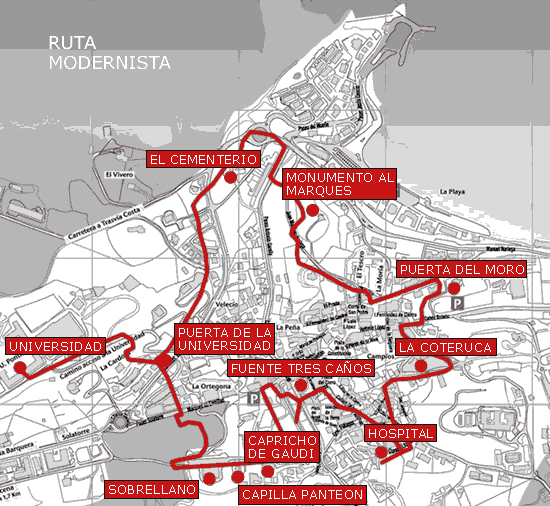 The Plan de Excelencia Turística of Comillas offers you several attractions that will help you discover, visit and enjoy Comillas in many different ways.
The Plan de Excelencia Turística of Comillas offers you several attractions that will help you discover, visit and enjoy Comillas in many different ways.


 The Plan de Excelencia Turística of Comillas offers you several attractions that will help you discover, visit and enjoy Comillas in many different ways.
The Plan de Excelencia Turística of Comillas offers you several attractions that will help you discover, visit and enjoy Comillas in many different ways.

Architect: Doménech i Montaner
Period: end of 19th century (1899)
Style: modernist
This is located in the Plaza de Joaquín del Piélago and was built in honour of Don Joaquín del Piélago, son in-law of the Marquis, for his collaboration in bringing domestic water to Comillas.
Doménech designed a column with three fountains at the pedestal which is decorated with plaques on which are written inscriptions of gratitude with vaguelly Gothic floral motifs. At the summit is a crown, a four-armed cross and a swimming dolphin as the main aquatic motif.
Architect: Joan Martorell
Supervised by: Cristóbal Cascante
Furnishing: Cascante, Camilo Oliveras
Paintings: Juan Roig, Eduardo Llorents
Building year: 1882-1888
Style: Neo-Gothic
Once the chapel-mausoleum was finished, the Sobrellano collection was completed with the construction of the palace.
This palace, which combines the architecture of English Gothic with some elements of Venetian stately homes and whose relief show a Mozarabic influence, was unveiled in 1888.
It is a simple structure with few elements of classical Gothic and consists of a foyer and a double marble staircase illuminated by the sunlight coming in through stained-glass windows that makes an almost perfect geometric floor plan.
The basic shape of the building is embellished with the rich decoration of its main façade and to a lesser extent at the back.
The marquis’s palace is definitely an impressive building full of beautiful things that reflect the character of the marquises of Comillas.
The grand salon was designed as a ceremonial reception room and subsequently its walls were filled with frescos painted by Eduardo Llorens consisting of different scenes showing the collaboration of the marquisate to the Spanish history.
Architect: Gaudí
Supervised by: A. Cascante
Building year: 1883-1885
Builder: José Pardo
Style: modernist
This summer house was built for Máximo Díaz de Quijano, the Marquis’ s wife’s brother-in-law. Working with a plan designed by Gaudí, Cascante Colom begun to construct it in 1883.
It has a lower-ground floor, a first floor and an attic. The building is outstanding because of the highly decorated tower which contrasts with the horizontal layers of the building. On the first floor there is a living room with a very high ceiling, a dining room and several other rooms. The garage, the kitchen and the servants’ quarters are located in the lower-ground-floor and the attic.
The façade, which combines brickwork and sunflower tiles rests in a solid stone base. These floral motifs also decorate the upper frieze, the tower and the lintels at every opening.
Above the porch rises the tower which is supported by solid columns whose capitals are decorated with naturalistic palm leaves and swallows. Inside it, there is an spiral staircase that leads to a balcony.
The porch and the tower stand out because of the round wrought-iron banisters, with curving uprights, decorated with vine leaves.
The wrought-iron balconies are also remarkable for their wooden benches and their canopies. Gaudí also designed blinds that emit musical sounds when they are opened or closed.
Architech: Martorell
Supervised by: Camilo Oliveras
Furnished by: A.Gaudi
Sculpture: Llimona y Vallmitjana
Year of construction: 1878-1881
Style: Neo-Gothic
The chapel was constructed as part of the Sobrellano ensemble. It is a good example of how Modernism evolved from Classicism.
The architect who build this cathedral in miniature, that recalls the devotion of the man who funded it, the second Marquis of Comillas, Don Claudio López Bru, was inspired by English Perpendicular Gothic.
It houses the mausoleums of the first marquis, his brother Claudio López y López and Doña Benita Diaz de Quijano (1881). It is considered to be one of the most significant examples of Modernist Catalan architecture in Cantabria. The sculptures of “La Plegaria” and ” La Resignación” evoke Rodin and their themes are related to the light and the atmosphere that derive from them. The three were sculpted by the Catalan and modernist artists Jose LLimona y Barbany and Agapito Vallmitjana.
Within the chapel stands out the presbytery, which was magnificently decorated with an altar and a bronze polished table bearing the symbols of the Gospel, the Agnus Dei and the Sacred Heart. Gaudí also designed some of the furnishings, which were mainly inspired by the Gothic but with some modernist nuances.
The chapel-mausoleum was inaugurated in 1881, during the royal visit of Alfonso XII.
Architect: Doménech Y Montaner
Year: 1892
This is the main entrance to the University, which once was enlarged to enable vehicular passage. It is a combination of brickwork, ceramic tiles and the carved stone of its shield, which contains the crown, the pontifical keys and the Jesuits’ anagram, JHS standing for “Jesús Salvador de los Hombres”, Jesus, Saviour of Men.
This splendid shield is carried by two pageboys, wearing sumptuous robes on which appear the year when the university was inaugurated and the Pope to whom it was offered, Leo XIII.
Beneath the pageboys, there are two grotesque figures, reminiscent of Eastern art, framed by an arch decorated in an exotic and medieval style.
The doors, which nowadays are missing once, were decorated with Passionflowers, symbolizing Jesus Christ.
Architect: Martorell
Supervised by: Cascante
Decorated by: Luis Doménech y Montaner
Paintings: Eduardo Llorens(auditorium), Juan Llimona y José M. Tamborín (church)
Year of Construction: 1883-1892
Style: Eclectic neo-Gothic neo-Mudejar
Once the Marquis’s palace had been built, the Marquis, who would be remembered for his pious works, decided to found an important school of higher education. This finally became a Seminary for the poor and a Pontifical University, run by the Jesuits, who used teaching methods that had been in vogue since the seventeenth century.
The building structure followed the Jesuits’ models, which were based on a rectangular floor plan consisting of two courtyards and a church between them.
Joan Martorell begun to built it as an Eclectic and Gothic-Mudejar building. Later, in 1889, Doménech y Montaner added some modernist touches such as the auditorium, the church, main hall, staircase, bronze door, tiles and the coffered ceiling to break the harshness of the original building.
Architect: Doménech y Montaner
Supervised by: Llimona
Year of construction: 1893
Style: modernism
Luis Doménech y Montaner refurbished the cemetery that stands on the ruins of an ancient Gothic church. He designed a surrounding wall, which is decorated with picturesque elements such as the pinnacles, the four-armed crosses and the main entrance arch.
Doménech wanted to emphasize the ruin, so on a corner of the ancient wall he added the marble sculpture of the Guardian Angel designed by José Llimona (1894-1985). The architect also designed the family crypt for Don Joaquín del Piélago where he added some modernist nuances such as a twisted wave on the surface of the tomb.
He achieved a mood of timelessness, expressed by the ambivalent and solemn calm of the angel that stands on a corner like a bird, in contrast with the faded ruins. These ruins tell us a story of an old lady who was attending the services on a Sunday afternoon. She was seated in the pew reserved for the Duke of the Infantado, the feudal Lord, and was ordered to budge. There were many arguments and it was finally decided to remove that particular pew but it was too late for the congregation that had sworn never to return and had already moved to the Hermitage of Saint John, the ancient Town Hall.
As a result the townspeople decided to build a new temple, away from the dead and protected from the strong winds, in the neighbourhood now called Barrio de la Iglesia.
They put aside a day a week to work on the church, thus, they spent more than two centuries on its construction.
Architect: Doménech y Montaner
Supervised by: Cascante
Year of construction: 1890
Period: Modernism
The emigrant Antonio López y López became incredibly rich and well known after his return from Cuba and when he settled in Barcelona. In 1878 King Alfonso XII awarded him with the marquisate of Comillas, his birthplace, in gratitude for his help and economic support during the Cuban conflict.
From then onwards the history of Comillas became interwoven with the marquis to whom this statue was dedicated.
The monument was erected on a property of Angel Pérez, a friend of the marquis, who had given it to the town for that purpose and was paid for by the Town Council.
Doménech used Cascante’s plan to build this original ship-like pedestal and the column that carries the image of the marquis. It is magnificently decorated with maritime motifs and it used to be remarkable for the bronze statues, allegories of the Antilles and the Filipines that as well as the image of Antonio López were unfortunately torn down during the Spanish Civil War.
Architect: Gaudi
Supervised by: Julián Bardier Pardo
Year of construction: 1900
Period: Modernism
This is located in the house in whose square tower hangs an enormous sculpture of the Sacred Heart.
Moro’s gate was built in 1900 and it is made of cut stone, a material that had been traditionally used for the construction of small walls. Gaudí reused it in this doorway to add some touches of fantasy. From then on this technique would be utilized amongst the cubist painters.
There is an entrance for cars, another for people and a small opening in the wall for birds called the gate for little birds. Its rounded and curving shapes show nuances of Modernismo.
Year of construction: 1870 – 1871
Style: French historicism
This was the summer house of the Riera family, which became the property of the Marquis of Movellán who has occupied it from then on. This building was constructed according to a plan that came from France.
It is a castellated mansion on the top of the hill overlooking the sea and is enhanced by the beauty of the landscape it decorates.
The ensemble transmits its picturesque essence through its crenelated walls, the wrought-iron cresting and the Gothic ruin-like enclosure.
There is a shield carved on the wall that carries a crown. From the crown overhangs a gauntlet brandishing a missing dagger. We can see the same motif in one of the quarters of the shield, where it overhangs the bust of an armed knight.
In one of the chimneys in the Sobrellano Palace there is the same emblem sculpted in wood that also bears the legend of the Bracho’s.
After the Civil War only the two square towers and the enclosing walls remained. In 1990 the building was refurbished and divided into apartments.
Architect: Cristóbal Cascante
Builder: Placido Díaz de La Campa
Year of Construction: 1885
Style: Modernismo
Claudio López and Benita Díaz de Quijano paid for this building, which is currently a residential home for the elderly, run by the Sisters of San José. In the main hall stands a bust of Don Claudio López y López sculpted by Agapito Vallmitjana (1888).
Even though the original plan was lost the building has been refurbished, but its wooden front gallery still recalls the Sobrellano palace. There is a porch that leads into the chapel of Nuestra Señora del Carmen, whose image is on the mahogany Gothic altarpiece. There is a central courtyard enclosed by the building. On the north façade there are two extended sections that give “movement” to the construction as well as the gallery which make up this impressive construction.